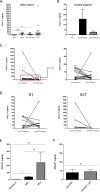Partial recovery of peripheral blood monocyte subsets in head and neck squamous cell carcinoma patients upon radio(chemo)therapy is associated with decreased plasma CXCL11
- PMID: 38609887
- PMCID: PMC11015641
- DOI: 10.1186/s12885-024-12177-x
Partial recovery of peripheral blood monocyte subsets in head and neck squamous cell carcinoma patients upon radio(chemo)therapy is associated with decreased plasma CXCL11
Abstract
Background: Head and neck squamous cell carcinoma (HNSCC) represents a common and heterogeneous malignancy of the oral cavity, pharynx and larynx. Surgery and radio(chemo)therapy are the standard treatment options and also have great influence on the composition of the tumor microenvironment and immune cell functions. However, the impact of radio(chemo)therapy on the distribution and characteristics of circulating monocyte subsets in HNSCC are not fully understood.
Methods: Expression patterns of adhesion molecules and chemokine receptors CD11a (integrin-α L; LFA-1), CD11b (integrin-α M; Mac-1), CD11c (integrin-α X), CX3CR1 (CX3CL1 receptor) and checkpoint molecule PD-L1 (programmed cell death ligand-1) were investigated upon radio(chemo)therapeutic treatment using flow cytometry. Furthermore, comprehensive analysis of plasma cytokines was performed before and after treatment using ELISA measurements.
Results: Our data reveal a partial recovery of circulating monocytes in HNSCC patients upon radio(chemo)therapeutic treatment, with differential effects of the individual therapy regimen. PD-L1 expression on non-classical monocytes significantly correlates with the individual plasma levels of chemokine CXCL11 (C-X-C motif chemokine 11).
Conclusions: Further comprehensive investigations on larger patient cohorts are required to elucidate the meaningfulness of peripheral blood monocyte subsets and chemokine CXCL11 as potential bioliquid indicators in HNSCC with regard to therapy response and the individual immunological situation.
Keywords: Adhesion molecules; CXCL11; Head and Neck squamous cell carcinoma; Monocyte subsets; PD-L1; Radio(chemo)therapy.
© 2024. The Author(s).
Conflict of interest statement
The authors declare no competing interests.
Figures






Similar articles
-
1,8-Cineol Attenuates Checkpoint Molecule PDL-1 and Adhesion Molecule CX3CR1 in Circulating Monocytes in Otitis Media Patients.J Pers Med. 2024 Mar 1;14(3):279. doi: 10.3390/jpm14030279. J Pers Med. 2024. PMID: 38541021 Free PMC article.
-
Correlation of Intra-tumoral and Peripheral PD-1/PD-L1 Immunity in Head and Neck Cancer.Anticancer Res. 2023 Dec;43(12):5349-5358. doi: 10.21873/anticanres.16738. Anticancer Res. 2023. PMID: 38030173
-
Plasma‑derived CD16 exosomes and peripheral blood monocytes as correlating biomarkers in head and neck cancer.Oncol Lett. 2023 Apr 4;25(5):200. doi: 10.3892/ol.2023.13786. eCollection 2023 May. Oncol Lett. 2023. PMID: 37113401 Free PMC article.
-
PD-L1 expression in the microenvironment and the response to checkpoint inhibitors in head and neck squamous cell carcinoma.Oncoimmunology. 2020 Nov 19;9(1):1844403. doi: 10.1080/2162402X.2020.1844403. Oncoimmunology. 2020. PMID: 33299655 Free PMC article. Review.
-
Programmed Cell Death-Ligand 1 in Head and Neck Squamous Cell Carcinoma: Molecular Insights, Preclinical and Clinical Data, and Therapies.Int J Mol Sci. 2022 Dec 6;23(23):15384. doi: 10.3390/ijms232315384. Int J Mol Sci. 2022. PMID: 36499710 Free PMC article. Review.
References
-
- Lacas B, Carmel A, Landais C, Wong SJ, Licitra L, Tobias JS, et al. Meta-analysis of chemotherapy in head and neck cancer (MACH-NC): an update on 107 randomized trials and 19,805 patients, on behalf of MACH-NC Group. Radiotherapy Oncology: J Eur Soc Therapeutic Radiol Oncol. 2021;156:281–293. doi: 10.1016/j.radonc.2021.01.013. - DOI - PMC - PubMed
MeSH terms
Substances
LinkOut - more resources
Full Text Sources
Medical
Research Materials
Miscellaneous

